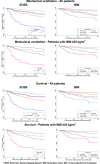The utility of the Edmonton Obesity Staging System for the prediction of COVID-19 outcomes: a multi-centre study
- PMID: 34974543
- PMCID: PMC8873002
- DOI: 10.1038/s41366-021-01017-8
The utility of the Edmonton Obesity Staging System for the prediction of COVID-19 outcomes: a multi-centre study
Abstract
Background: Patients with obesity have an increased risk for adverse COVID-19 outcomes. Body mass index (BMI) does not acknowledge the health burden associated this disease. The performance of the Edmonton Obesity Staging System (EOSS), a clinical classification tool that assesses obesity-related comorbidity, is compared with BMI, with respect to adverse COVID-19 outcomes.
Methods: 1071 patients were evaluated in 11 COVID-19 hospitals in Mexico. Patients were classified into EOSS stages. Adjusted risk factors for COVID-19 outcomes were calculated and survival analysis for mechanical ventilation and death was carried out according to EOSS stage and BMI category.
Results: The risk for intubation was higher in patients with EOSS stages 2 and 4 (HR 1.42, 95% CI 1.02-1.97 and 2.78, 95% CI 1.83-4.24), and in patients with BMI classes II and III (HR 1.71, 95% CI 1.06-2.74, and 2.62, 95% CI 1.65-4.17). Mortality rates were significantly lower in patients with EOSS stages 0 and 1 (HR 0.62, 95% CI 0.42-0.92) and higher in patients with BMI class III (HR 1.58, 95% CI 1.03-2.42). In patients with a BMI ≥ 25 kg/m2, the risk for intubation increased with progressive EOSS stages. Only individuals in BMI class III showed an increased risk for intubation (HR 2.24, 95% CI 1.50-3.34). Mortality risk was increased in EOSS stages 2 and 4 compared to EOSS 0 and 1, and in patients with BMI class II and III, compared to patients with overweight.
Conclusions: EOSS was associated with adverse COVID-19 outcomes, and it distinguished risks beyond BMI. Patients with overweight and obesity in EOSS stages 0 and 1 had a lower risk than patients with normal weight. BMI does not adequately reflect adipose tissue-associated disease, it is not ideal for guiding chronic-disease management.
© 2021. The Author(s).
Conflict of interest statement
MRF has received support from Medtronic, CONACYT, Novo Nordisk and Merck; EWGT has received support from Wyeth Science Centre; RM has received fees as speaker or advisor from Abbott, Amgen, Astra Zeneca, Boehringer Ingelheim, Janssen, Novo Nordisk, Sanofi and Silanes; LGMA has received fees from Novo Nordisk, Lilly, Merck and Sanofi. The rest of authors declare no competing interests.
Figures


Similar articles
-
Comparing body mass index and obesity-related comorbidities as predictors in hospitalized COVID-19 patients.Clin Obes. 2022 Jun;12(3):e12514. doi: 10.1111/cob.12514. Epub 2022 Feb 22. Clin Obes. 2022. PMID: 35194933 Free PMC article.
-
Predicting COVID-19 outcomes with the Edmonton Obesity Staging System.Ann Saudi Med. 2024 Mar-Apr;44(2):116-125. doi: 10.5144/0256-4947.2024.116. Epub 2024 Apr 4. Ann Saudi Med. 2024. PMID: 38615185 Free PMC article.
-
Obesity class versus the Edmonton Obesity Staging System for Pediatrics to define health risk in childhood obesity: results from the CANPWR cross-sectional study.Lancet Child Adolesc Health. 2019 Jun;3(6):398-407. doi: 10.1016/S2352-4642(19)30056-2. Epub 2019 Apr 3. Lancet Child Adolesc Health. 2019. PMID: 30952624
-
Usefulness of the Edmonton Obesity Staging System for stratifying the presence and severity of weight-related health problems in clinical and community settings: A rapid review of observational studies.Obes Rev. 2020 Nov;21(11):e13120. doi: 10.1111/obr.13120. Epub 2020 Aug 19. Obes Rev. 2020. PMID: 32812345 Review.
-
Obesity in patients with COVID-19: a systematic review and meta-analysis.Metabolism. 2020 Dec;113:154378. doi: 10.1016/j.metabol.2020.154378. Epub 2020 Sep 28. Metabolism. 2020. PMID: 33002478 Free PMC article.
Cited by
-
Obesity in Adults: A 2022 Adapted Clinical Practice Guideline for Ireland.Obes Facts. 2022;15(6):736-752. doi: 10.1159/000527131. Epub 2022 Oct 24. Obes Facts. 2022. PMID: 36279848 Free PMC article. Review.
-
Review of an international pilot project to adapt the Canadian Adult Obesity Clinical Practice Guideline.Obes Pillars. 2023 Sep 27;8:100090. doi: 10.1016/j.obpill.2023.100090. eCollection 2023 Dec. Obes Pillars. 2023. PMID: 38125658 Free PMC article. Review.
-
[Adaptation of the Edmonton Obesity Staging System to Brazilian PortugueseAdaptación del sistema de estadios de la obesidad de Edmonton al contexto brasileño].Rev Panam Salud Publica. 2025 Jun 10;49:e62. doi: 10.26633/RPSP.2025.62. eCollection 2025. Rev Panam Salud Publica. 2025. PMID: 40496838 Free PMC article. Portuguese.
-
More than just body mass index: Using the Edmonton obesity staging system for pediatrics to define obesity severity in a multi-ethnic Australian pediatric clinical cohort.Obes Sci Pract. 2022 Dec 23;9(3):285-295. doi: 10.1002/osp4.648. eCollection 2023 Jun. Obes Sci Pract. 2022. PMID: 37287524 Free PMC article.
-
Comparing body mass index and obesity-related comorbidities as predictors in hospitalized COVID-19 patients.Clin Obes. 2022 Jun;12(3):e12514. doi: 10.1111/cob.12514. Epub 2022 Feb 22. Clin Obes. 2022. PMID: 35194933 Free PMC article.
References
-
- Peng YD, Meng K, Guan HQ, Leng L, Zhu RR, Wang BY, et al. Clinical characteristics and outcomes of 112 cardiovascular disease patients infected by 2019-nCoV. Zhonghua Xin Xue Guan Bing Za Zhi. 2020;48:450–5. - PubMed
-
- Shamah-Levy T, Cuevas-Nasu L, Gaona-Pineda EB, Gómez-Acosta LM, Morales-Rúan MDC, Hernández-Ávila M, et al. Sobrepeso y obesidad en niños y adolescentes en México,actualización de la Encuesta Nacional de Salud y Nutrición de Medio Camino 2016. Salud Publica Mex. 2018. - PubMed
Publication types
MeSH terms
LinkOut - more resources
Full Text Sources
Medical

